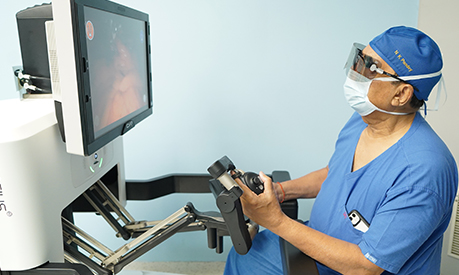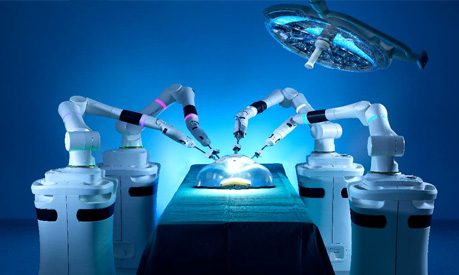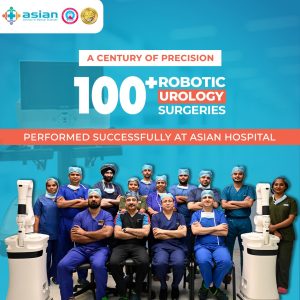Asian Centre for Robotic Surgery
The Asian Institute of Robotic Surgery is considered the best hospital for robotic surgery in Faridabad, Haryana, India and is committed to providing patients with excellent clinical outcomes. Robotic surgery is a minimally invasive surgery performed with the assistance of a robotic surgical system. The state-of-the-art operating theatres are equipped with the Versius surgical system, the most advanced platform for minimally invasive surgery available today. Introducing, Advanced 3D Robotic Surgery for complete curative cancer surgery and perfect reconstructive surgery even in inaccessible areas. The four-armed surgical robotic system is a breakthrough in surgical technology and is used in the specialties of Oncology, Urology, Thoracic Surgery, and General Laparoscopic procedures such as Gall Bladder Stones, Hernia, Appendicitis, among several other complex procedures. In addition, robotic surgery for the treatment of prostate, kidney, and urinary bladder cancer has proved to be highly beneficial to patients.

This is yet another ‘First in the Region’ advancement by Asian Healthcare.
Robotic Surgery treatment in India at Asian Hospitals offers many benefits to patients as compared to open surgery, including:
- A shorter hospital stay – the patient is usually discharged the same day.
- Post-surgery discomfort and pain reduced

- Recovery time is faster and normal activities can be resumed more quickly
- Reduced risk of infection due to smaller incisions
- Transfusions and blood loss were reduced by less than 10%
- There is a minimum amount of surgical scarring on the body.
Our technology, infrastructure, clinical expertise, and patient-centric approach make us one of India’s best robotic surgery hospitals.
Robotic surgery is becoming more accessible in India due to its cost-effectiveness and increasing availability of trained surgeons.
Various surgical procedures can be performed with robotic surgical systems, such as:
Kidney & Prostate Cancer
A kidney tumour is an abnormal growth of kidney cells called nephrons. Surgery is considered the main treatment for most kidney cancers.
Robotic surgical systems help in removing precise kidney tumour and helps with kidney reconstruction. There is an excellent chance of kidney preservation as there is a low rate of operative complications.
When compared to traditional laparoscopy, Robotic surgery requires shorter operation time. The blood loss is also less.
Prostate cancer is a disease in which malignant (cancer) cells form in the tissues of the prostate. The prostate is a gland in the male reproductive system located just below the bladder and in front of the rectum.
Robotic Surgery is used for the more precise removal of cancerous tissue. It also can perform nerve sparring surgery, enabling a better chance for the return of urinary continence and faster recovery of erectile (sexual) function. There is a lower risk of complications, injury to the rectum, and injury to the nerve. This surgery is less painful, and the blood loss extent is also less.
Gynae Cancer Surgery
The new robotic surgical systems allow many women to undergo gynecologic surgery with minimally invasive procedures rather than open surgery.
In addition to the benefits offered by conventional laparoscopic surgery, robotic surgery offers even greater advantages, including shorter hospital stays, less blood loss, faster recovery, better cosmesis, and fewer to no complications. Robotic surgeries overcome the drawbacks of limited operative field visualization and the requirement for a skilled surgical assistant.
Weight Loss Surgery
Robotic bariatric surgery is a novel helpful approach for people wishing to lose weight. This procedure is safe and effective, and doctors can perform gastric bypass, sleeve gastrectomy & other weight loss procedures.
In this system, the surgeon controls tiny instruments used during surgery from a console near the patient in the operating room. In addition, doctors can view through an optic camera, which delivers 3D high-definition views.
The Robotic system provides the surgeon with a 3-Dimensional magnified view of the operating field, which increases precision and accuracy in surgical movements.
Kidney Transplant
In robotic-assisted surgery, our surgeons use a computer-controlled robotic arm to perform the transplant. The surgeons direct the arm’s movements and use tiny instruments inserted through small incisions to transplant the donor’s kidney.
Both transplant recipients and living kidney donors benefit from robotic-assisted surgery. Other benefits include:
- Smaller incisions
- Less scarring
- Reduced pain
- Lower risk of infection
- Faster recovery
Uterus & Cervix Cancer
Robotic surgical systems technology has facilitated the application of minimally invasive techniques for treating and evaluating patients with early, advanced, and recurrent cervical cancer. In addition, robotic systems have been associated with faster performance times, improved accuracy, enhanced agility, faster suturing, and fewer errors when used in preset laboratory drills.
Our Experts

Dr. Ved Prakash
Chairman- General Surgery, Minimal Invasive, Bariatric & Robotic Surgery

Dr. Pankaj Kumar Hans
Director & Head Unit (II)- General, Laparoscopic, Bariatric, Laser & Robotic Surgery
 Appointment
Appointment  Lab Report
Lab Report Find a Doctor
Find a Doctor  Health/Lab Packages
Health/Lab Packages  Beware of Fraudulent Activities in the name of Asian Hospital, Faridabad.
Beware of Fraudulent Activities in the name of Asian Hospital, Faridabad. 











